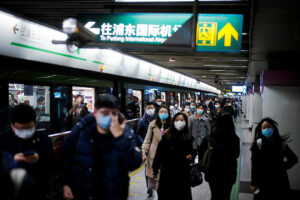BEIJING — As many Chinese embraced new found freedoms on Thursday after the country dropped key parts of its tough zero-COVID regime, some cities warned residents to maintain vigilance against a virus that, until now, has been largely kept in check.
Three years into the pandemic, many in China had been itching for Beijing to start to align its rigid virus prevention measures with the rest of the world, which has largely opened up in an effort to live with the disease.
Those frustrations boiled over into widespread protests last month, the biggest show of public discontent since President Xi Jinping came to power in 2012.
Without saying it was a response to the protests, some cities and regions began relaxing COVID controls, in moves that heralded a nationwide loosening of the rules unveiled by the National Health Commission (NHC) on Wednesday.
The NHC said infected people with mild symptoms can now quarantine at home and it dropped the need for testing and health status apps for a variety of activities including travelling around the country.
Domestic ticket sales for tourist and leisure spots have soared, according to state press, while some people took to social media to reveal they had tested positive for the virus — something that had previously carried heavy stigma in China.
Others expressed caution.
“I know COVID is not so ‘horrifying’ now, but it is still contagious and will hurt,” said one post on the Weibo platform. “The fear brought to our heart cannot be easily dissipated.”
China reported 21,439 new COVID-19 infections on Dec. 7, compared with 25,321 a day earlier.
“Too many positives!” said another Weibo user.
ILL-PREPARED
Top officials have been softening their tone on the dangers posed by the virus in recent weeks, bringing China closer to what other countries have been saying for more than a year as they dropped restrictions.
But, while announcing the implementation of the new measures late on Wednesday, some cities urged residents to remain vigilant.
“The general public should maintain a good awareness of personal protection, and be the first responsible person for their own health,” Zhengzhou, the central city home to the world’s largest iPhone factory, said in a message to residents.
It urged residents to wear masks, maintain social distancing, seek medical attention for fever and other COVID symptoms and, especially for the elderly, to get vaccinated.
Some analysts and medical experts say China is ill-prepared for a major surge in infections, partly due to low vaccination rates among vulnerable, older people and its fragile healthcare system.
“It (China) may have to pay for its procrastination on embracing a ‘living with COVID’ approach,” Nomura analysts said in a note on Thursday.
Infection rates in China are only around 0.13%, “far from the level needed for herd immunity,” Nomura said.
Feng Zijian, a former official in China’s Center for Disease Control, told the China Youth Daily that up to 60% of China’s population could be infected in the first large-scale wave before stabilizing.
“Ultimately, around 80%-90% of people will be infected,” he said.
China’s current tally of 5,235 COVID-related deaths is a tiny fraction of its population of 1.4 billion, and extremely low by global standards. Some experts have warned that toll could rise above 1.5 million if the exit is too hasty. — Reuters

